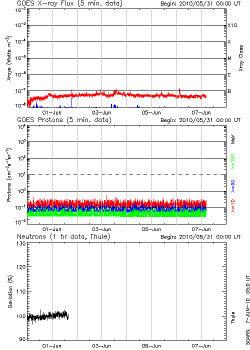
POES Proton data from NOAA/SEC
| |||||||||
| |||||||||
|
Cosmic radiation can be of galactic and solar origins and
can affect both avionics and humans.
The main component of the radiation is the galactic cosmic ray
background - this is modulated by the solar cycle and can be
enhanced by solar activity.
[more - science]
If an intense solar flare occurs, the level of radiation can increase. The top two panels in the plot of the left show the X-ray flux and proton flux measured by the GOES spacecraft - if these show significant increases there may be enhanced radiation levels. The polar map (top right) shows where protons are precipitating in the polar region as measured by the POES spacecraft. The bottom panel of the plot on the left shows the neutron flux measured at ground level and is a measure of the cosmic ray flux. Decreases can be caused by the passage of CMEs (so called Forbush Decreases); rises can be caused by solar flares. Note: The SEC Radiation Storm flag does not properly indicate a possible increase in the radiation levels at commercial aircraft altitudes. High energy particle measurements (Protons >100 MeV) are a better indicator of radiation risk to passengers and crew - see the green line on the proton plot (centre panel). |